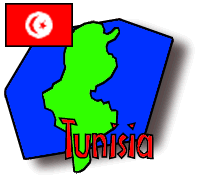topics: medina, harissa (food), computer technology; jump to dispatch
BikeAbout Log

Rider Notes: October 21–22, 1997
Breakfast: While in Tunis, we made a practice of having bread available around the house to use in the morning when we broke our nighttime fast (hence the name "break-fast"). This was supplemented with cheese and/or pastries, and coffee and/or tea.
Lunch: For lunch, we ducked into one of the non-touristy shops that provide more rudimentary, but always delicious local fare. As in Morocco, we selected from an assortment of prepared or quickly-cooked foods, and the guy behind the counter piled it into a plate for us: roast chicken and french fries, mixed salad (with too many onions), méchouia, etc.
Dinner: Since andrEa and Corinne have been hard pressed sometimes to get the vegetarian food they crave, they took advantage of the at-home-in-Tunis feel we have and cooked a purely vegetarian feast for everyone. We were all treated to some deliciously "hot" homemade curried lentils with brown rice. Yum! Corinne experimented a little too much with the hot peppers and, although Ethan liked it, Padraic was forced to drink nearly every ounce of water in the house to douse the fire in his mouth.
Food of the Day: Harissa
Harissa is a (sometimes very) spicy condiment found all over Tunisia (and elsewhere in North Africa), and used especially with couscous, soups, and meat. It is a purée made from small hot peppers, oil, garlic, and spices like cayenne and coriander. It is always a red color (like the peppers from which it is made), although the reds can be very different: harissa made from fresh steamed peppers is usually bright red and must be eaten before a week has passed; harissa made from dried peppers and left for 12 hours before use, can be covered with olive oil and kept for a long time. It has a much darker and (justifiably) more threatening color of red.
Person of the Day: Mr. Zoubeïr Mouhli
Mr. Zoubeïr Mouhli is an urban architect and Head Coordinator of the Architecture and Urbanism Department at the Association Sauvegarde de la Médina de Tunis (Association for the Safekeeping of the Medina of Tunis). His work, along with some 50 others (including a team of 14 architects), has been to preserve and enhance the unique qualities of Tunis' Medina (see the Place of the Day). Since 1967, the Association has had a growing roster of Medina-based projects, some of which have been recognized and rewarded by very prestigious groups (including three awards from the world-famous Agha Khan Foundation for Architecture).
Some of the most ambitious work has been the restoration of Dar Lasram (the palace in which the Association has made its home), and the Hafsia/Oukala operation which reversed a process of urban blight in the central Medina that began in the 1920s. At that time, wealthy families moved out of the Medina, leaving their homes to be subdivided and turned into multi-occupancy houses, or oukalas. Some 866 Medina families were re-housed to allow for the restorative work that had to be done.
Mr. Mouhli and the Association Sauvegarde de la Médina de Tunis are at the forefront of some difficult work. But, as they say in their literature: "The future is full of promise . . . "
If you would like to learn more about the Association Sauvegarde de la Médina, please write to:
- Association Sauvgarde de la Médina
- 24, rue du Tribunal
- 1006 Tunis, Tunisia
Place of the Day: Medina of Tunis 


The Medina, or old town, of Tunis, is one of the best preserved Arab Muslim cities in the world and well deserves its listing as a World Heritage site recognized by UNESCO. With a history that stretches back to at least the 8th century AD, today's Tunis, and especially the Medina, has maintained (with the help of some concerned people and organizations — see the Person of the Day) its rich geographical, architectural, religious, and cultural (is there even anything else?) heritage. The Medina covers 270 hectares (667 acres, or slightly more than one square mile) and is home to more than 100,000 people.
This medina, like those we visited in Morocco (Tetouan, Chefchaouen), is also a dizzying maze of narrow and crowded streets, full of life and energy, colors and smells, and an overwhelming sense of history. Imagine being in an outdoor flea market — or souk (also suq) as they are called in Tunisia — that has been packed and stuffed and crammed into little stalls all concentrated into one relatively small area so that it seems like you could find the material to build an entire home — plus all the furniture and clothes and food and other odds and ends that you could ever need — all in a tiny space that would easily fit in the pedestrian zone of most American malls! Everywhere you turn there are little shops full of bright colors and music and incense, all selling clothes, carpets, souvenirs, ceramics, jewelry, furniture and furnishings, antiques, books, food and drink, and many, many things — new and old — that we are completely unable to identify! It's almost overwhelming. And very easy to get lost in.  And that is only the beginning. There are also regular houses, mosques, palaces, cemeteries, mausoleums, hammams (Turkish baths), schools, medersas (traditional schools from earlier times), bakeries, artisans' workshops, courtyards, and gardens.
All in all, today we look at the Medina like it is a city within a city. But we should not forget that it, with its northern and southern suburbs, was once the whole city of Tunis, before the new city was built during the colonial times.
The Medina developed over centuries and the knots of living areas — separate from the commercial zones — and crisscrossing streets grew out of a concern for maintaining haram, or privacy. This tradition is also seen in the architecture. Buildings are always very modest and imposing from the outside, but once you get inside, WOW! Interior courtyards and beautiful rooms decorated with colored tiles, carved plaster, painted wood ceilings, marble floors, and columns. Incredible.
And that is only the beginning. There are also regular houses, mosques, palaces, cemeteries, mausoleums, hammams (Turkish baths), schools, medersas (traditional schools from earlier times), bakeries, artisans' workshops, courtyards, and gardens.
All in all, today we look at the Medina like it is a city within a city. But we should not forget that it, with its northern and southern suburbs, was once the whole city of Tunis, before the new city was built during the colonial times.
The Medina developed over centuries and the knots of living areas — separate from the commercial zones — and crisscrossing streets grew out of a concern for maintaining haram, or privacy. This tradition is also seen in the architecture. Buildings are always very modest and imposing from the outside, but once you get inside, WOW! Interior courtyards and beautiful rooms decorated with colored tiles, carved plaster, painted wood ceilings, marble floors, and columns. Incredible.
Group Dispatch, October 21–22

Tuesday and Wednesday were basically group catch-up and rest days. We were weary after our four weeks of continuous travel (yes, travel can be difficult, even when it is incredibly fun) and we had some "technical" problems to deal with. For a few weeks our computers have been suffering from a spreading virus and we had all been in communication withdrawal, having had difficulty making regular and sustainable contact with friends, families, and new BikeAbout schools at home in the States. Some of us had also fallen behind in our dispatch writing. So, except for a few outings to pick up information, get food, or enjoy the sun, all five of us stayed in and, well, we basically did our homework. Yuck. But we did succeed in eliminating the dreaded BLEAH-A virus from our trusty Compaq laptops, reformatted some things on our hard drives, readjusted things on our bikes, caught up on our email, studied information about the cities we will be visiting in the weeks ahead, and even watched some TV movies. It was great to be lazy for the first time in so long!
Finally, on Wednesday evening, Ethan, Padraic and Anthony were welcomed to the Association Sauvegarde de la Médina de Tunis (Association for the Safekeeping of the Medina of Tunis) by Mr. Zoubeïr Mouhli (see the Person of the Day). andrEa and Corinne stayed back at the house to prepare for our regular 1-3 p.m. EST Wednesday live chat 'n' debate — see the BikeAbout Discussions page.
At the Association, we shared information about BikeAbout with Mr. Mouhli and some of his colleagues and then he gave us a guided tour of the magnificently restored Dar (Palace) Lasram, which is home to his association. The palace and its confusing maze of rooms (we would have been lost without Mr. Mouhli) left us with a deeper understanding of haram, or privacy, in the Medina (see the Place of the Day). The palace's relatively plain exterior revealed none of the gentle and tasteful wealth of architectural refinement and careful attention inside, all of which had been painstakingly restored by the Association. Passing from reception areas and inner rooms for eating and sleeping, and separate quarters for guests and servants, we felt like we were discovering a whole new world. A world inside the miniature world of the Medina, which is inside the world of Tunis. A world within a world within a world. Like being inside a microscope and getting to the smaller and smaller details!
After the visit of the palace, Mr. Mouhli invited the three guys to his house for tea and fresh fruit. His home, on the western edge of the Medina, was an apartment in another amazing maze of a building. He took us through a wonderful winding stretch of comfortable rooms all wrapped around a little courtyard where stories and more cultural information were shared.
When the guys returned home, hungry and tired, they were horrified to find that andrEa and Corinne had devoured (like some wild beasts!) every single one of the cookies kindly brought over by the next door neighbors. They didn't even left three little crumbs on the plate! Though disappointed, everyone was happy to hear that the weekly Chat 'n' Debate went well. After more work on the computers, everyone headed off to bed to prepare for tomorrow's early visit to Carthage.
Questions? Ask Ethan  !
!



Copyright 1997-2004 BikeAbout. All rights reserved.
![]()
![]()
![]()
![]()

![]() !
!




